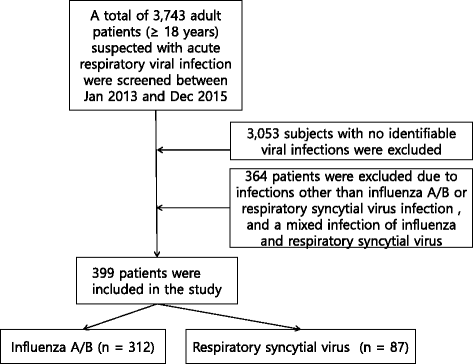Risk of mortality associated with respiratory syncytial virus and influenza infection in adults
- PMID: 29262784
- PMCID: PMC5738863
- DOI: 10.1186/s12879-017-2897-4
Risk of mortality associated with respiratory syncytial virus and influenza infection in adults
Abstract
Background: Respiratory syncytial virus (RSV) infection constitutes a substantial disease burden in the general population. However, the risk of death for RSV infection has been rarely evaluated with confounders or comorbidities adjusted. We aimed to evaluate whether RSV infection is associated with higher mortality than seasonal influenza after adjusting for confounders and comorbidities and the effect of oseltamivir on the mortality in patients with influenza infection.
Methods: A retrospective cohort study was conducted on adult (≥18 years) patients admitted to the emergency department and ward of a university teaching hospital for suspected viral infection during 2013-2015 (N = 3743). RSV infection was diagnosed by multiplex PCR (N = 87). Adults hospitalized for seasonal influenza during the study period were enrolled as a comparison group (n = 312). The main outcome was 20-day all-cause mortality.We used Cox proportional hazard regression analyses to calculate the relative risk of death.
Results: Adult patients were less likely to be diagnosed with RSV than with influenza (2.3 vs 8.3%, respectively), were older and more likely to be diagnosed with pneumonia, chronic obstructive pulmonary disease, hypoxemia, and bacterial co-infection. In patients with RSV infection, the 20-day all-cause mortality was higher than that for influenza, (18.4 vs 6.7%, respectively). RSV infection showed significantly higher risk of death compared to the seasonal influenza group, with hazard ratio, 2.32 (95% CI, 1.17-4.58). Oseltamivir had no significant effect on mortality in patients with influenza.
Conclusions: RSV infection was significantly associated with a higher risk of death than seasonal influenza, adjusted for potential confounders and comorbidities.
Keywords: Influenza, human; Mortality; Respiratory syncytial viruses.
Conflict of interest statement
Ethics approval and consent to participate
The current study was approved by the institutional review board at Dongsan Hospital, Keimyung University School of Medicine. The need for written informed consent was waived. This study was conducted in compliance with the Declaration of Helsinki.
Consent for publication
Not applicable
Competing interests
The authors declare that they have no competing interests.
Publisher’s Note
Springer Nature remains neutral with regard to jurisdictional claims in published maps and institutional affiliations.
Figures




References
MeSH terms
Grants and funding
LinkOut - more resources
Full Text Sources
Other Literature Sources
Medical

